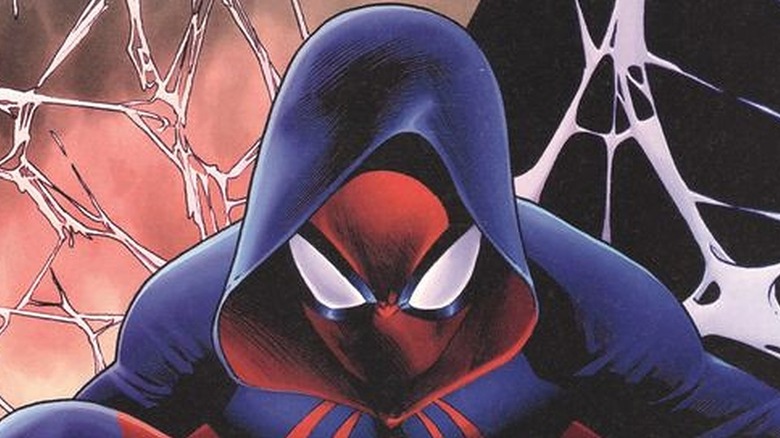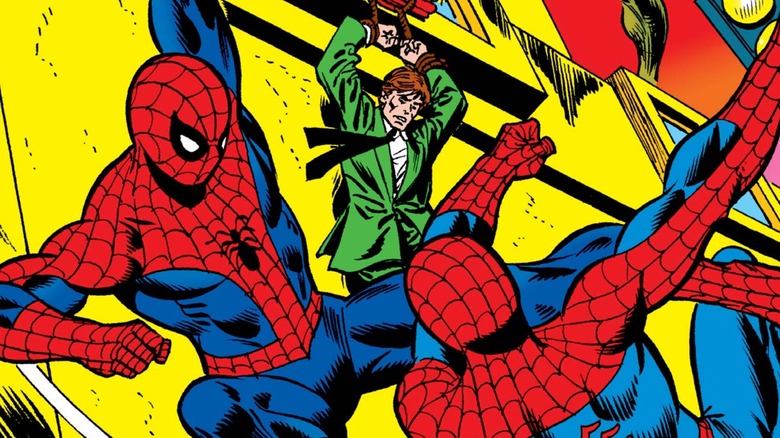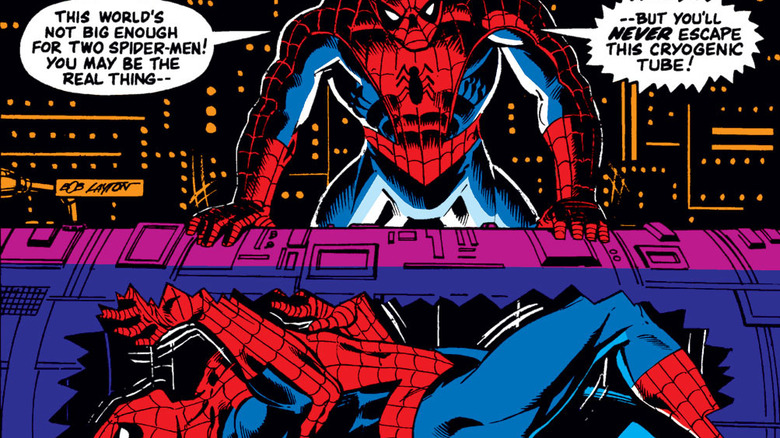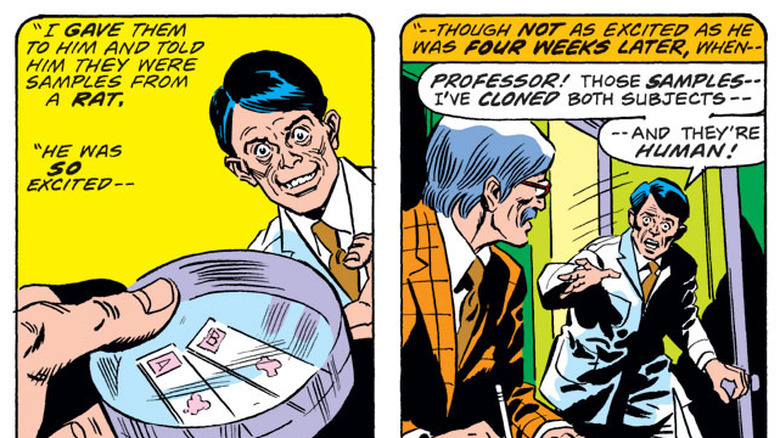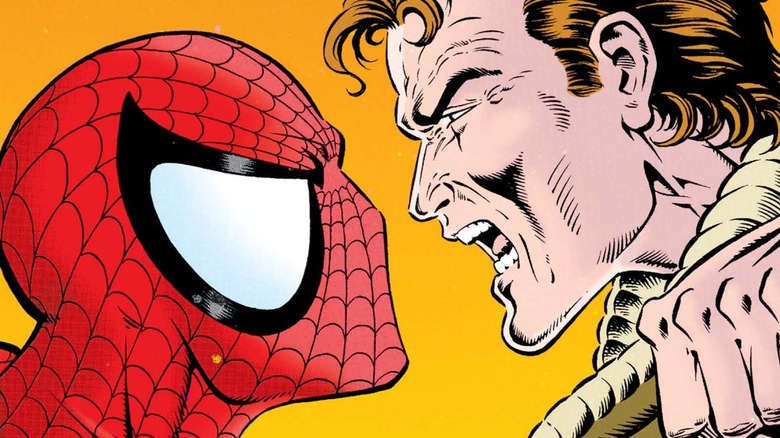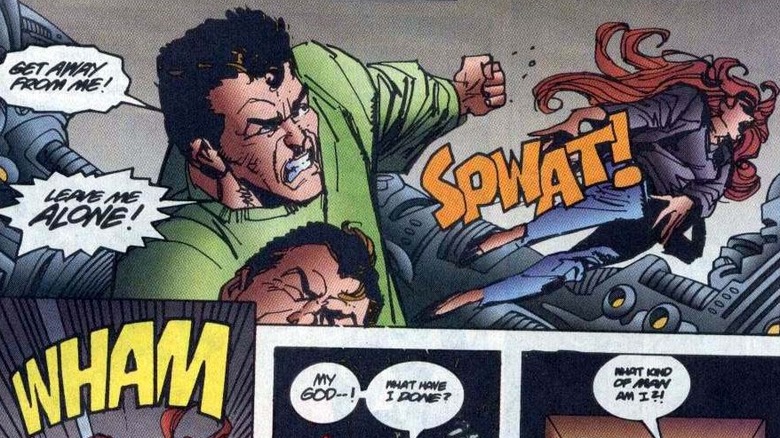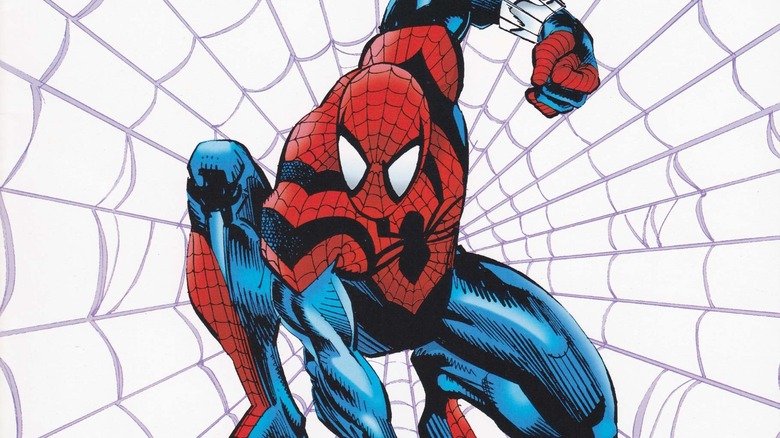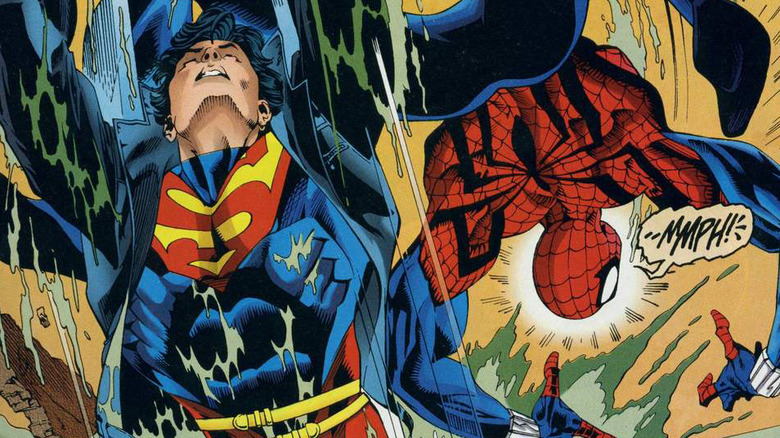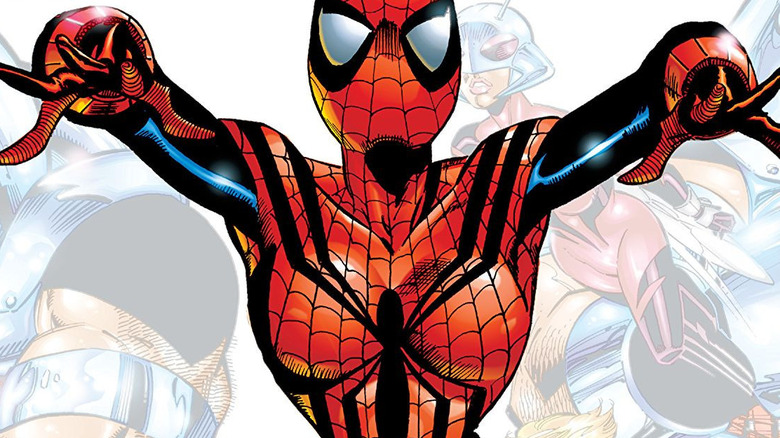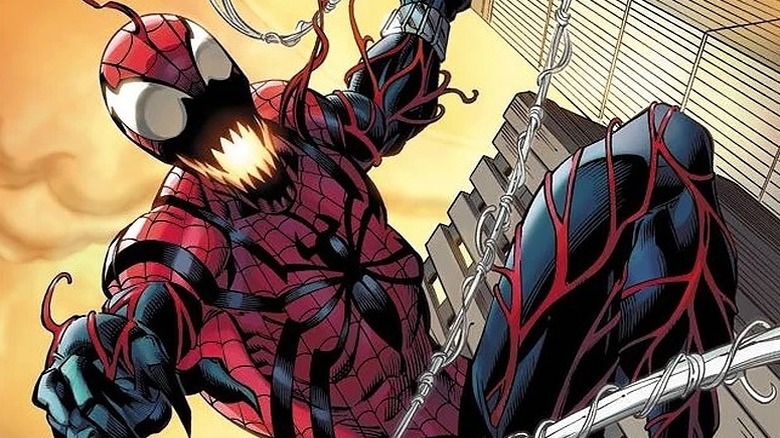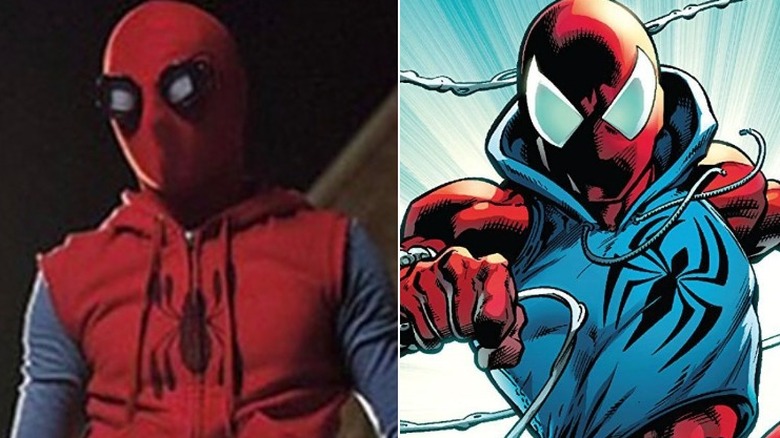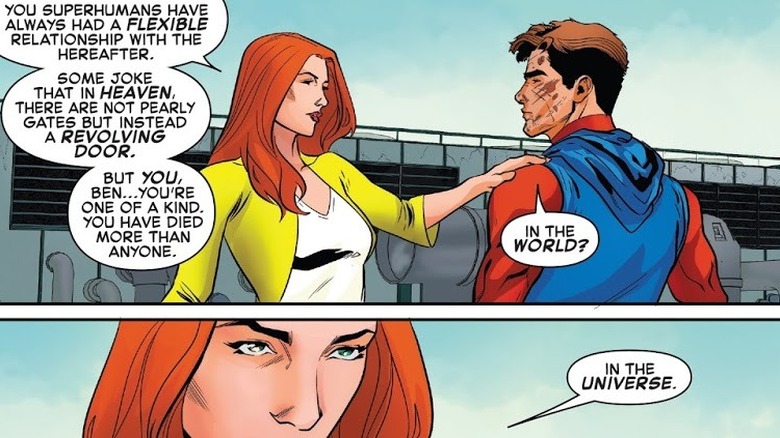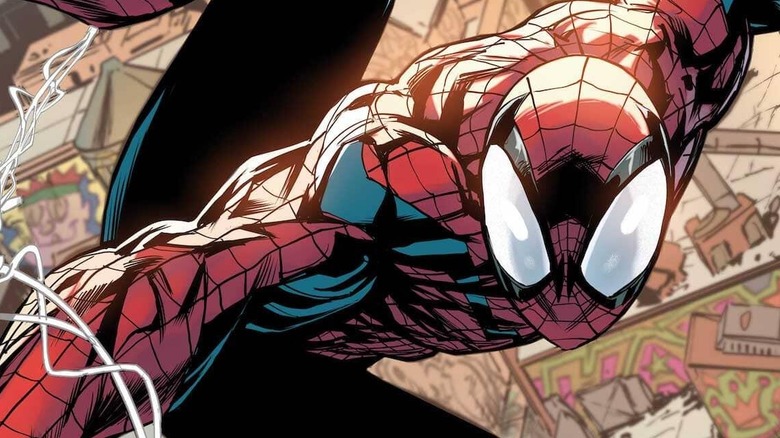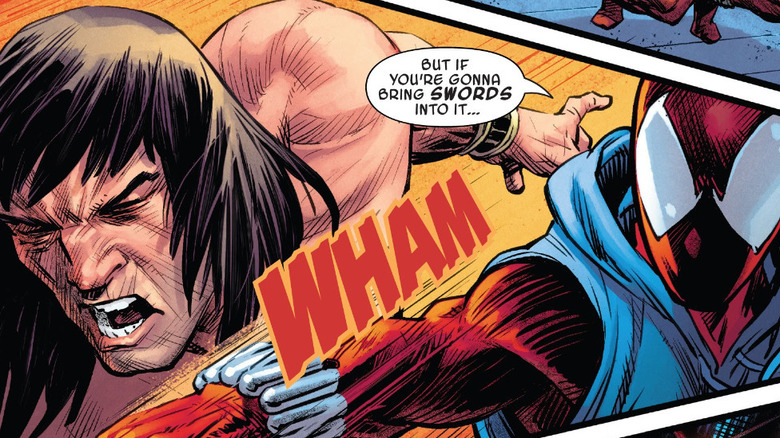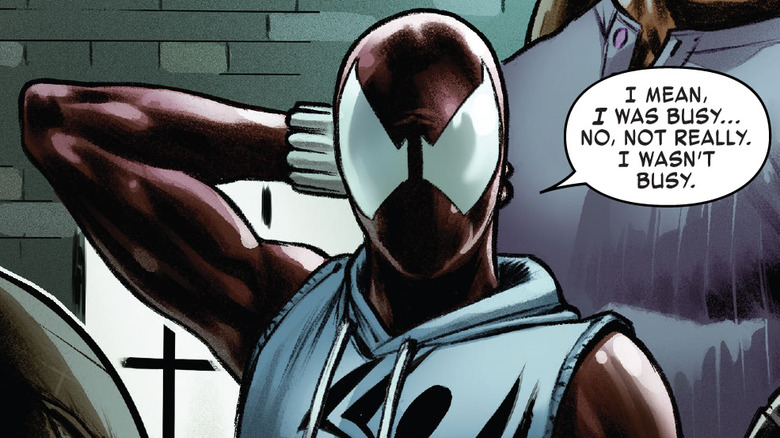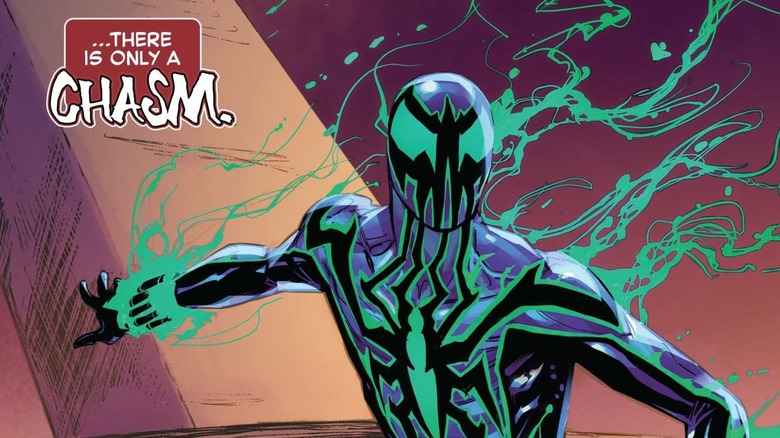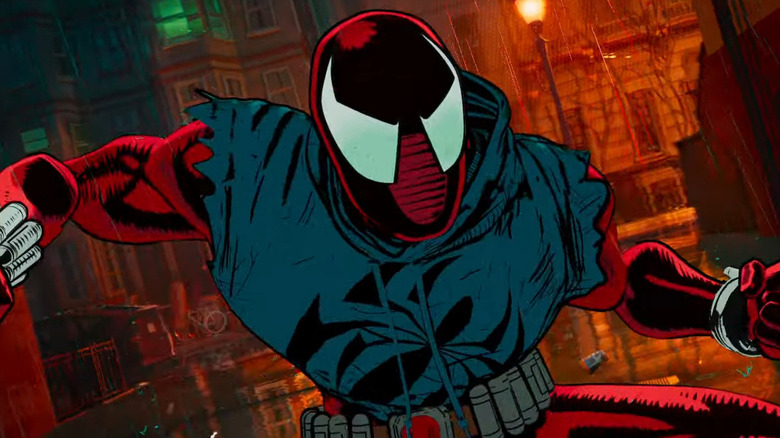The Untold Truth Of Spider-Man's Clone, Ben Reilly
Think Peter Parker's life is tough? Try being his clone.
Despite his decades of publication history and strong connection to Marvel's most popular character, Benjamin Reilly never really caught a proper break. In the comics, he is a lab-created copy of one of Earth's greatest heroes, with all of the powers and emotional baggage but none of the legitimacy. In reality, he started out as an extension of an absurd story idea, a throwaway concept that, were it not for corporate interference, would have been little more than a forgotten footnote in comic book history. And when Ben finally got his shot at stardom, it was sandwiched within a convoluted story arc that overstayed its welcome — one that was so reviled, even its animated adaptation took potshots at it.
Here is the untold truth of Spider-Man's clone, Ben Reilly: who he is (and isn't), his complicated character journey, and how he became one of the few good things to come out of the infamous '90s "Clone Saga" in the Spider-books.
Ben Reilly started out as a nameless, one-off character
When writer Gerry Conway introduced Spider-Man's clone — a creation of the villainous Jackal, who is secretly Peter's former professor Miles Warren — in the pages of 1975's "Amazing Spider-Man" vol. 1 #149, he didn't really plan for the character to ever return, especially since Conway himself was already leaving the title. In an interview published in Back Issue, Conway agreed that the Spider-Clone, who wasn't even given a proper name in the story, was a "one-and-done" character: "I figured [the Spider-Clone] would be in and out, we would do it and then we would never do anything with it again."
The idea of Spider-Man's clone came to Conway as part of a larger story involving the return of Peter Parker's love Gwen Stacy, who died in the pages of "Amazing Spider-Man" vol. 1 #121 (which he also wrote). According to Conway, Stan Lee thought that offing Gwen was a "terrible mistake" that had to be corrected no matter what. Conway decided that bringing a clone of Gwen into the book for a short-term storyline would be the most interesting way to go about it — and that to take the fun and ridiculousness of the story a notch higher, they should clone Peter, too. "One of the things I was trying to do at that time was take ideas to their logical, yet absurd conclusion, reductio ad absurdum ... And I thought, if we can clone Gwen, we can certainly clone Peter."
A 1981 What If? comic made the Spider-Clone's return seem absurd
The premise of Marvel's "What If?" comic book series is quite straightforward. Each issue shows how some of the publisher's most famous and significant stories would have ended if even just a single detail changed. These stories often end in characters' deaths, villains' victories, or even the destruction of the universe, but there are a handful have outcomes that aren't downright awful. One such example is 1981's "What If?" vol. 1 #30, which not only provides closure and a somewhat happy ending for Spider-Man, but also confirms that in official continuity, the Spider-Clone was originally meant to stay dead.
"What If Spider-Man's Clone Lived?" switches things around by having the genetic duplicate gain the upper hand over the original during their showdown. Thinking that he's the genuine article, the Spider-Clone puts the original in a cryogenic stasis pod and goes out into the world. However, he eventually figures out that he's actually the clone — and that he is way in over his head, thanks to an ambush by the Kingpin and his goons that nearly kills him.
He goes back to Professor Warren's laboratory and frees Peter, who concocts a plan to defeat the Kingpin. At the end of the story, Peter and his clone work out a way to take alternating "shifts" as both Spider-Man and Peter Parker, allowing them to enjoy some peace in their personal lives while still fulfilling their crimefighting responsibilities.
Not a clone, but a man infected with a 'clone virus'?
In 1989, Gerry Conway had another opportunity to revisit the story of the clones of Gwen Stacy and Peter Parker. Strangely enough, he used it to establish that they weren't actually clones, but real people who were genetically modified to look like Gwen and Peter. In fact, former Marvel writer Glenn Greenberg revealed in the "Clone Saga" retrospective Life of Reilly that Conway "went to great lengths to undo his own stories [about the clones] from years before."
"Spectacular Spider-Man" vol. 1 #149 shows Peter discovering the alleged truth behind the Jackal's "fake" clones. He finds the journals of Miles Warren and learns that Warren didn't really unlock the secret of human cloning; instead, he manufactured a genetic virus that could modify a person's DNA to make them look like someone else. According to the journal, the duplicate Peter fought back in "Amazing Spider-Man" vol. 1 #149 was actually a man named Anthony Serba, Warren's lab assistant. Meanwhile, the Gwen Stacy "clone" was originally a woman named Joyce Delaney. After a battle with a genetically modified villain called Carrion, Peter visits Gwen's grave, finally coming to terms with her death and letting her go.
In one of many convoluted twists more tangled than Spidey's web, this retcon was also retconned six years later in "Spider-Man" vol. 1 #56. In the span of two pages, the Jackal re-establishes that the doubles were indeed clones and not genetic mutants — and that the "journal" was just full of lies.
The Spider-Clone's return became a heavily guarded secret
In the second installment of Life of Reilly, former Spider-Man editor Mark Bernardo revealed that the seeds of the Spider-Clone's return were planted at a 1993 Marvel writers' conference, brought about by management's mandate to publish a Spider-Man story to match DC Comics' "Death of Superman" in both impact and sales. Writer Terry Kavanagh proposed reviving Peter Parker's clone, who appeared to have died in the battle against the original (and whose corpse was seemingly incinerated in a smokestack two issues later).
Other writers initially balked at the idea, until they "realized the radical possibilities of such a storyline." Thus, the Spidey brain trust quickly planned exactly how they could bring the clone back, while quietly having him appear as a "mystery man" in the Spider-books for months leading up to the reveal.
Based on Glenn Greenberg's recollection of events, the clone's return was the Spider-office's most heavily guarded secret: Only the teams working on books relevant to the story knew what was going to happen. As Greenberg was not involved with any of the Spider-Man titles at the time, he only learned about the idea after bugging Bernardo, his close friend, to tell him. Greenberg's reaction "was one of absolute dismay," as he felt that revisiting the clone story was a mistake.
Nevertheless, the '90s "Clone Saga" kicked off as planned, with Spider-Man and his double finally meeting face-to-face once more in 1994's "Spectacular Spider-Man" vol. 1 #216.
Marvel tried very, very hard to make readers like Ben Reilly
According to Mark Bernardo, the team planned to conclude the story of the Spider-Clone (who names himself "Ben Reilly" to honor Peter's uncle Ben Parker and aunt May Reilly) in "Amazing Spider-Man" vol. 1 #400 by revealing that Ben was the real Spider-Man and Peter, whose adventures readers followed for two decades, was the clone. Bernardo explained that this was an attempt to "simplify Spider-Man's mythos and ultimately bring him 'back to basics.'" To make this idea stick, however, Marvel had to make readers like Ben first.
In their confrontation in "Web of Spider-Man" vol. 1 #117, Ben is depicted as rational and level-headed; Peter, on the other hand, is aggressive and emotional, having been traumatized by recent events. Moreover, Ben is painted as the more selfless and heroic of the two. Case in point: His first mission as Scarlet Spider in "Web of Spider-Man" vol. 1 #118 is to take down Venom. "The story of Ben's victory over Venom was very important," explained Greenberg in Life of Reilly. "It was specifically designed to show how cool a character Ben is, to get the readers to be impressed with him and really root for him."
When the big revelation finally drops in "Spectacular Spider-Man" vol. 1 #226, Peter is so shaken that he strikes his pregnant wife, Mary Jane. Intent notwithstanding, it's a despicable action — one that may have been written to further endear Ben to readers by comparison.
For a time, Ben Reilly was the 'real' Spider-Man (and then he wasn't)
Following Ben's reinstatement, Peter and Mary Jane decide to leave New York. Ben officially becomes Spider-Man in "Sensational Spider-Man" vol. 1 #0, sporting a brand new costume. Throughout his tenure, Ben deals with Peter's old foes as well as new threats. He also has to reintegrate himself into the superhero community, with many of Peter's closest allies (such as the Human Torch, Daredevil, and the Black Cat) being distrustful of him. He even becomes part of some major storylines, such as the cataclysmic X-Men crossover "Onslaught" that briefly takes many Marvel heroes off the board.
Behind the scenes, however, Ben's career as Spider-Man was doomed as soon as it began. As Glenn Greenberg revealed in Life of Reilly, writer Dan Jurgens and Spider-Man Group EIC Bob Budiansky had a meeting at the 1995 Chicago Comic-Con around the time Ben officially debuted as Spider-Man. A new mandate emerged: Bring back Peter. The justification? "Longtime readers could not be asked to accept that the character they followed for so long wasn't the 'real' guy. The new status quo was offensive to those longtime readers, and confusing to any newcomers who happened to wander in to check out what all the hype and controversy was about."
And so, the messy story that had dragged on for two years concluded in 1996's "Spider-Man" vol. 1 #75, which killed off Ben and revealed that Peter was, in fact, the original Spider-Man.
Ben Reilly met heroes from DC and Image — but not from Marvel 2099
Ben's run as Spider-Man was brief, but it certainly had its highlights. He becomes part of not one, but two inter-company events: a crossover with DC Comics that temporarily merged two comic book universes, and a two-part team-up with an Image Comics character.
"Marvel Versus DC" vol. 1 #3 pits the sensational Spider-Clone against a fellow genetic duplicate from the other side of the superhero fence: Superboy, a teenaged clone of Superman with DNA from both the Man of Steel and his arch-nemesis, Lex Luthor. In the story, Spider-Man and Superboy fight for the fates of their respective universes; since a real-world popularity poll decided the outcome of the fight, Spider-Man emerges as the victor, despite their wide power gap. Meanwhile, the limited series "Backlash/Spider-Man" features the wall-crawler teaming up with the immortal member of the super-team called Stormwatch, as they work together to take down Venom and the Cabal.
One hero Ben didn't meet, however, was the Spider-Man of the year 2099. Despite knowing what would transpire in the Spider-books, writer Peter A. David decided to feature Peter Parker in the one-shot "Spider-Man 2099 Meets Spider-Man" rather than Ben Reilly, strongly believing that the latter's tenure wouldn't last. "[I]f we did go with Ben, then when Peter Parker returned to the fold as the one and only Spider-Man, then the crossover would just be this bizarre footnote rather than the definitive meeting I wanted it to be."
Ben Reilly: the heroic inspiration of Spider-Man's daughter
Two years after the "Clone Saga" conclusion, "What If?" vol. 2 #105 presented an interesting alternate scenario revolving around Peter Parker's present and future. In the mainstream continuity (Earth-616), Peter and Mary Jane's baby girl is stillborn, and Peter simply reclaims the Spider-Man name after Ben Reilly's death. This story reveals what would have happened if the child survived.
Fifteen years after Peter's return, May "Mayday" Parker is a high school basketball superstar who inherited her father's powers — and is completely unaware that her father used to be Spider-Man. When a dangerous threat from Peter's past reemerges and threatens his family's safety, Mary Jane reveals the truth to Mayday, who leaps into action wearing Ben Reilly's Spider-Man uniform. The character proved to be enough of a hit that she eventually headlined her own comic series, set in the alternate Marvel future known as MC2.
Oddly enough, it took four years in real time before the subject of Mayday's own "uncle Ben" was thoroughly explored in her book. In "Spider-Girl" vol. 1 #44, Peter and Mayday have a long-overdue conversation about Ben Reilly, with the former finding creative ways to simplify the complicated "Clone Saga" to his daughter (such as describing Ben as a distant relative instead of a clone) while cementing Ben's heroic legacy. (In a strange twist, someone else assumes the costume and identity of the Scarlet Spider in this era: Felicity Hardy, the daughter of the Black Cat.)
Ben Reilly became a supervillain ... twice
Being a clone of one of Marvel's greatest heroes doesn't mean immunity from occasional bouts of villainy. In the case of Ben Reilly, there have been at least two instances where he became the very thing he swore to fight — and one of them marked his return to comics after staying dead for two decades of publication time.
In "Amazing Spider-Man" vol. 1 #410, the Carnage symbiote unexpectedly takes over Ben during a battle at the Ravencroft Institute. Ben struggles to keep Carnage's murderous impulses in check, but fails. He stops short of becoming a killer only through the timely intervention of Peter Parker, who also helps free Ben from the symbiote. Interestingly, a version of Ben completely possessed by Carnage served as the final antagonist of the '90s "Spider-Man" animated series.
Ben officially returns to the land of the living in "Dead No More: The Clone Conspiracy" #3. Driven mad after being repeatedly murdered and resurrected by a Miles Warren clone seeking the secret of immortality, Ben eventually turns the tables on his captor. He becomes the new Jackal, planning to resurrect every dead person in Peter's life through cloning. After being chastised by Peter for his irresponsible actions, Ben sends all of Peter's revived friends and foes after him. The duplicates eventually suffer the effects of degeneration, and Ben escapes in the ensuing chaos. Seeking to redeem himself, he moves to Las Vegas and becomes the Scarlet Spider once more.
Did Ben Reilly's costumes inspire MCU Spider-Man's suits?
For comic book fans, it's hard not to look at the Marvel Cinematic Universe's incarnation of Spider-Man and see the influences of Ben Reilly's iconic costumes on the fledgling wall-crawler's suits.
Take MCU Peter Parker's homemade suit, for example: a simple red mask and sleeveless hoodie, worn over blue long-sleeved pajamas. Fans first got a better look at this DIY ensemble in 2017's "Spider-Man: Homecoming," particularly when Peter donned it in his final battle against the Vulture. It shares striking similarities with the Scarlet Spider suit, except with the colors switched around; interestingly, unused art from Marvel Studios concept artist Ryan Meinerding reveals a design that looks exactly like a live-action interpretation of Ben's makeshift suit (via ComicBook.com).
On the other hand, while the Iron Spider Armor's name and extra appendages in the MCU are clearly influenced by its comic book counterpart, the mask and the massive spider on its chest (besides the gold trim) bring Ben's Spider-Man costume to mind.
Ben Reilly holds a morbid record in the Marvel universe
When the newly returned Ben Reilly decides to carve a new path for himself, one Spider-person doesn't take it sitting down: Kaine, a disfigured Peter Parker clone who's assumed the Scarlet Spider identity in Ben's absence. Believing that Ben must pay for his crimes as the Jackal, Kaine tracks him down to Las Vegas, determined to be the only Scarlet Spider in town. However, his attempt to kill Ben in "Ben Reilly: The Scarlet Spider" vol. 1 #7 fails miserably when Kaine suddenly dies from an unexpected cause: the touch of the personification of Death herself, who pays Ben a personal visit for a special reason.
During Ben's conversation with Death, the otherworldly entity reveals that out of everyone in the entire universe, Ben holds the record for the highest number of deaths. Unfortunately, this also means that Ben's soul has traveled back and forth from the afterlife multiple times, leaving it damaged "to its very core." According to Death, it would only take another death and resurrection to turn Ben evil permanently — but if he manages to stay alive long enough, his soul will eventually repair itself. Death brings Kaine back to life upon her departure, and the encounter leaves Ben even more determined to regain his heroic status.
Ben Reilly, the corporate-sponsored Spider-Man
Ben's short-lived career as Spider-Man ended with his first death in "Spider-Man" vol. 1 #75 (and to really drive the point home, Marvel even added the words "Peter Parker" to that book's title). Thus, it's an interesting coincidence — or perhaps, an intentionally designed wink to the past — that Ben's second shot at being the "one and only" Spider-Man officially starts in another 75th issue.
"Amazing Spider-Man" vol. 5 #75 kicks off the "Beyond" era of the Spider-Man mythos, which sees Ben operating in full capacity as Spider-Man after Peter Parker sustains serious injuries. The story "Test Drive" from Marvel's Free Comic Book Day 2021 giveaway offers readers a glimpse of what Ben's brand-new Spider-Man costume (courtesy of the mysterious Beyond Corporation) can do: In a hostage situation involving the cybernetically enhanced villain Bushwacker, the suit's "impact-thickening, foam-based polymers" manage to withstand bullets at close range. After Ben defeats Bushwacker and frees his hostages, a Beyond representative builds up the clone's confidence, calling him "the real Spider-Man."
No matter how many unexpected twists manifest in Ben's life, one thing is clear: The clone who just won't stay down always strives to measure up to his progenitor.
He fought the legendary Conan the Barbarian ... and lost miserably
Spider-folks are typically experts at dealing with street-level threats, and Ben Reilly is no exception. Upon reclaiming the mantle of the Scarlet Spider, Ben decides that the best way to improve his rep after the mess he made as the Jackal would be to deal with the thugs and hooligans of Las Vegas, Nevada. Unfortunately, this puts him at odds with an opponent who normally shouldn't be there — and the results are quite embarrassing for the hoodie-wearing webslinger, to say the least.
In 2020's "Conan: Battle for the Serpent Crown," the legendary Conan the Barbarian teams up with small-time burglar Nyla Skin to obtain the Serpent Ring from the Black Cat. While running away from the scene of a crime, the duo run afoul of Ben, who proves to be a speedy source of irritation for the mighty Cimmerian. With his trusty Spider-sense and webshooters, he's able to dodge Conan's attacks and successfully strike the warrior in the face. All it takes to even the odds, however, is a dirty trick up Nyla's sleeve: a sudden burst of light that temporarily blinds the Scarlet Spider. Conan then takes the opportunity to pick up his opponent like a rag doll and throw him into a neon sign. The sudden surge of electricity proves to be too much for Ben, who immediately loses consciousness. Even Conan is unhappy with the outcome, feeling that the victory was achieved through mere trickery.
Joining Iron Man's team of knockoff Avengers
The Scarlet Spider is no newbie when it comes to team-ups. After all, he spent quite a bit of time with the New Warriors after returning from his self-imposed exile way back in the '90s. With that said, he isn't exactly as high-profile as his progenitor Spider-Man, which means that he doesn't always get invitations to join major superhero teams like the Avengers. Interestingly enough, his relative obscurity in the Marvel universe turned out to be the precise reason for him being a prime candidate to join the ragtag team of an Avengers founder.
In 2021's "Iron Man" Vol. 6 #5, Tony Stark assembles a group of not-so-popular heroes for a particularly dangerous mission: to face off against the cosmic threat of longtime Avengers foe Korvac and save his best friend War Machine in the process. In this case, however, he needs allies that Korvac wouldn't be able to recognize and prepare for — and so, the armored hero recruits Ben (who at this point is moonlighting as a security guard for the Metropolitan Museum of Art) along with Misty Knight, Gargoyle, and Frog-Man to form what could (not so charitably) be called his bootleg Avengers.
Despite essentially being a bunch of C-listers (at best), this hastily assembled strike force still means enough to Iron Man for them to merit a cute name: the Space Friends. According to Tony, it emphasizes that "we're in space ... and you're my friends. Not my employees."
From hero to villain ... for the third time
Initially, Ben's turn as the Beyond Corporation's sponsored Spider-Man goes pretty well, as he operates with enough funding and tech support to make him a successful crimefighter. In fact, during this time, he proves that he's more than capable of filling in for Peter, who's lying in a coma after sustaining radiation poisoning from a confrontation with the U-Foes gone wrong. Additionally, Ben is reunited with the love of his life, Janine. Sadly, as with most good things in the Spider-clone's life, these happy times aren't meant to last.
When Ben comes close to unravelling the Beyond Corporation's true intentions for taking him under their wing, they subject him to mental modification via a memory-erasing device. However, this also leads to Ben losing many of the core memories he shares with Peter. He angrily storms Beyond's HQ to get answers, only to be manipulated into fighting the then-newly recovered OG Spider-Man. In the aftermath of their battle in "Amazing Spider-Man" Vol. 5 #93, Ben is transformed by a large amount of Beyond's quantum-shifting polymer into Chasm, a partially amnesiac villain with psionic powers.
The Dark Web storyline features the climax of Ben's third foray into supervillainy, as well as his downfall. Initially teaming up with fellow clone Madelyne Pryor, Ben as Chasm storms the streets of New York with the X-Men villain's demonic army. Ultimately, Madelyne has a change of heart, and imprisons Ben in Limbo's embassy in New York.
Ben Reilly's silver screen debut in Spider-Man: Across The Spider-Verse
The follow-up to 2018's award-winning animated film "Spider-Man: Into the Spider-Verse," the 2023 movie "Spider-Man: Across the Spider-Verse" represents a major milestone in the life of the sensational Spider-clone: It features the superhero's silver screen animation debut. But while this marks an important first in the character's decades-long existence, it isn't exactly the kind of faithful adaptation that most diehard fans would likely want to see.
Voiced by Andy Samberg, this version of Ben hails from Earth-94, acting as a member of the Spider Society formed by Miguel O'Hara, aka Spider-Man 2099 (Oscar Isaac). An over-the-top, muscle-obsessed meathead, the Scarlet Spider of "Across the Spider-Verse" is a deliberate smorgasbord of ridiculous '90s stereotypes. For starters, he looks like he jumped right out of a heavily inked comic book, making him instantly distinguishable whenever he's standing alongside the other Spider Society members. He also talks like someone out of a terrible comic book, complete with redundant comments stating the obvious and some good old grim and gritty introspection.
As it turns out, the poor Spider-clone can't catch a break anywhere, even in the animated world. His only noteworthy moments in "Across the Spider-Verse" involve him hilariously brooding with his mask off, putting Miles Morales (Shameik Moore) in the lamest chokehold in history, striking the "perfect pose" under the rainy sky of Earth-1610, and being outwitted and incapacitated by Gwen Stacy (Hailee Steinfeld) faster than you can say "Clone Saga."
